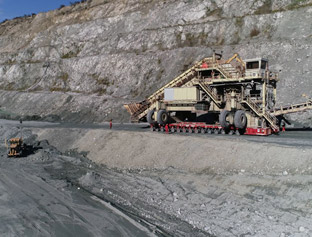Mammoet moves rock crusher in California
24 April 2019Mammoet has successfully transported a 690t granite rock crusher and primary conveyor inside the A.R. Wilson Quarry mining site in Aromas, California.
Both pieces of equipment needed to be relocated from the top of the quarry to a new location further down in the mine. Mine owner Graniterock had previously attempted to drive the rock crusher downhill themselves; however, the crusher experienced a loss of braking power and the operation could not be completed safely.
Mammoet was contracted because of their previous experience in mining equipment transport, and because of their proposed solution to move the crusher in one piece on SPMTs, whereas other proposals received included dismantling the rock crusher before transport.
Mammoet’s solution meant the machine could remain active until just hours before the move, which significantly reduced downtime of this vital piece of mining equipment and avoided any unnecessary wear and tear on the machine. The rock crusher is one of only two rubberised crushers in the world, it has rubber wheels and is drivable, and is the only crusher currently in use.
The quarry has been in operation since 1900, and by relocating the crusher, another 100 years of operation is expected.
Both pieces of mining equipment were moved to another section further down in the mine, approximately 1,200m (4,000ft) away. The route encountered an 8-10% grade at times and a lot of mud, following several days of rain. Each piece of equipment was moved using SPMTs. This allowed for a more controlled move as the rugged SPMT tyres provided the necessary traction to handle the grade challenge and mud.
The 152m primary conveyor was relocated first. Due to its length, the conveyor was broken down into four sections to facilitate transport downhill. Then, each section was jacked-up and transported by SPMTs to the new location further down in the mine. Once in place, a 450t gantry helped to position the old conveyor sections over a new conveyor before both were connected to form one larger unit.
The rock crusher followed, in one piece, with a total travel time of less than two hours. The entire operation was completed on schedule and with zero incidents, despite the challenging weather conditions.
